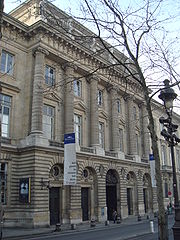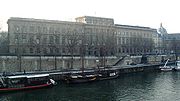
Hôtel des Monnaies, Paris
Encyclopedia


The hôtel des Monnaies is an 18th century building on the quai Conti in the 6th arrondissement of Paris
Paris
Paris is the capital and largest city in France, situated on the river Seine, in northern France, at the heart of the Île-de-France region...
. It has housed the Monnaie de Paris
Monnaie de Paris
The Monnaie de Paris or, more administratively speaking, the "Direction of Coins and Medals", is an administration of the French government charged with issuing coins as well as producing medals and other similar items. Many ancient coins are housed there...
ever since its construction. The nearest Paris Metro station is Pont Neuf
Pont Neuf (Paris Metro)
Pont Neuf is a station of the Paris Métro in the heart of old Paris and is connected to the Île de la Cité by the nearby Pont Neuf. It opened in 1926 with the extension of line 7 from Palais Royal - Musée du Louvre to Pont Marie....
.
It is the masterwork of the architect Jacques Denis Antoine
Jacques Denis Antoine
Jacques Denis Antoine was a French architect. His masterwork is the Hôtel des Monnaies in Paris, which gained him entrance to the Académie d'architecture in 1776....
(1733-1801), who in 1765 beat Étienne-Louis Boullée
Étienne-Louis Boullée
Étienne-Louis Boullée was a visionary French neoclassical architect whose work greatly influenced contemporary architects and is still influential today.- Life :...
and François Dominique Barreau de Chefdeville
François Dominique Barreau de Chefdeville
François Dominique Barreau de Chefdeville was a French architect.-Life:From a good middle-class Paris family, Bareau de Chefdeville studied architecture under Germain Boffrand and one first prize in the 1749 Prix de Rome for a "temple of peace, isolated, in the style of antique temples"...
in a competition to design it. Though it was his first major civic project he shows a high level of ingenuity. The first stone was laid by abbé Terray
Joseph Marie Terray
Joseph Marie Terray was a Controller-General of Finances during the reign of Louis XV of France, an agent of fiscal reform, cut short by his death....
on 30 April 1771. The riverside façade was completed in 1773 and the whole exterior and most of the interior by 1775. In 1776 the building won Antoine entrance to the Académie royale d'architecture. It is still considered a prime example of pre-Revolutionary
French Revolution
The French Revolution , sometimes distinguished as the 'Great French Revolution' , was a period of radical social and political upheaval in France and Europe. The absolute monarchy that had ruled France for centuries collapsed in three years...
French Neoclassical architecture
Neoclassical architecture
Neoclassical architecture was an architectural style produced by the neoclassical movement that began in the mid-18th century, manifested both in its details as a reaction against the Rococo style of naturalistic ornament, and in its architectural formulas as an outgrowth of some classicizing...
The building is typified by its heavy external rustication
Rustication (architecture)
thumb|upright|Two different styles of rustication in the [[Palazzo Medici-Riccardi]] in [[Florence]].In classical architecture rustication is an architectural feature that contrasts in texture with the smoothly finished, squared block masonry surfaces called ashlar...
and severe decorative treatment. It boasts one of the longest façade
Facade
A facade or façade is generally one exterior side of a building, usually, but not always, the front. The word comes from the French language, literally meaning "frontage" or "face"....
s on the Seine; its appearance has been likened to the Italian palazzo
Palazzo
Palazzo, an Italian word meaning a large building , may refer to:-Buildings:*Palazzo, an Italian type of building**Palazzo style architecture, imitative of Italian palazzi...
tradition. The building, which housed mint workshops, administrative rooms, and residential quarters, wraps around a large interior courtyard
Courtyard
A court or courtyard is an enclosed area, often a space enclosed by a building that is open to the sky. These areas in inns and public buildings were often the primary meeting places for some purposes, leading to the other meanings of court....
. It remains open to the public and includes a numismatics
Numismatics
Numismatics is the study or collection of currency, including coins, tokens, paper money, and related objects. While numismatists are often characterized as students or collectors of coins, the discipline also includes the broader study of money and other payment media used to resolve debts and the...
museum, located within what was once the main foundry
Foundry
A foundry is a factory that produces metal castings. Metals are cast into shapes by melting them into a liquid, pouring the metal in a mold, and removing the mold material or casting after the metal has solidified as it cools. The most common metals processed are aluminum and cast iron...
.
History


